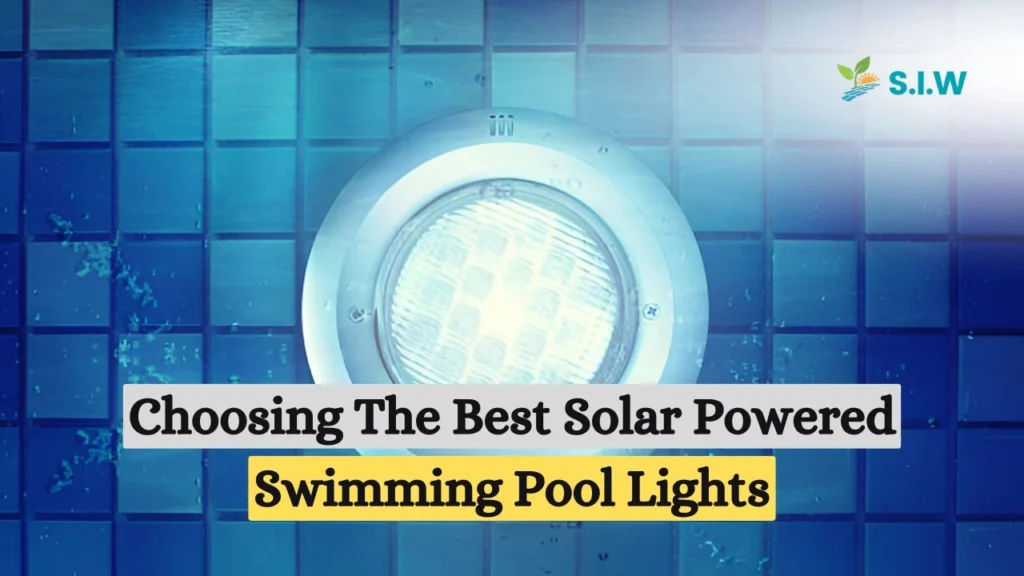Solar-powered swimming pool lights offer an eco-friendly, cost-effective solution to illuminate your pool, making your outdoor space both beautiful and energy-efficient. In this comprehensive guide, we will explore the factors to consider when selecting the best solar pool lights, the types available, and how to maximize their benefits. By the end, you’ll have all the information needed to make an informed decision.
Why Solar Powered Pool Lights?
Solar pool lights draw energy from the sun, reducing your electricity costs and your carbon footprint. They are ideal for anyone looking to make their pool area safer and more visually appealing without ongoing operational costs.
Benefits of Solar Pool Lights:
- Energy Efficiency: Uses solar energy to reduce electricity bills.
- Eco-friendly: Decreases reliance on non-renewable energy sources.
- Low Maintenance: Most models require minimal upkeep.
- Ease of Installation: No wiring or electrical installation required.
- Cost-effective: Free power source after installation.
Key Factors to Consider When Choosing Solar Pool Lights
1. Brightness and Lumens
Brightness is one of the most critical factors to evaluate when selecting solar pool lights. The brightness of a solar light is measured in lumens (lm). Higher lumens provide brighter light output.
Recommended Lumen Range:
- Decorative lights: 50-100 lumens
- Safety-focused lights: 200-400 lumens
- High-intensity lighting: 600+ lumens
2. Solar Panel Efficiency
The efficiency of the solar panel directly influences the light’s charging capability and run time. Look for lights with high-efficiency photovoltaic panels. Monocrystalline solar panels tend to perform better compared to polycrystalline.
Panel Types:
- Monocrystalline: Higher efficiency, longer lifespan.
- Polycrystalline: Less efficient but more affordable.
3. Battery Capacity
Battery capacity is crucial for ensuring the lights stay illuminated throughout the night. Solar lights typically come with lithium-ion or nickel-metal hydride (NiMH) batteries.
Battery Types:
- Lithium-ion: Higher energy density, faster charging, longer life.
- NiMH: More affordable, but shorter lifespan compared to lithium-ion.
Ensure the battery capacity can provide at least 8-12 hours of lighting on a full charge.
4. Durability and Waterproof Rating
Since pool lights are exposed to water and the elements, they must be robust and waterproof. Pay attention to the IP (Ingress Protection) rating. For pool environments, a minimum IP65 rating is recommended.
IP Ratings:
- IP65: Resistant to low-pressure water jets.
- IP67: Can be submerged in water for short durations.
- IP68: Suitable for prolonged underwater use.
5. Run Time and Charging Time
The ideal solar pool light should charge quickly and offer a long run time. A good solar light should provide at least 8-10 hours of illumination after charging for 6-8 hours in direct sunlight.
6. Aesthetic Design
Choose lights that complement the design of your pool and garden. Whether you prefer floating lights, underwater lights, or mounted lights, aesthetics play a significant role in enhancing the visual appeal.
7. Light Color and Modes
Many solar pool lights offer various colors and lighting modes. Consider lights with multiple settings, such as dimming, color-changing, or strobe effects, to set the desired mood around your pool area.
8. Installation Process
Ensure the lights you choose are easy to install. Most solar pool lights are either floating, placed on the pool deck, or secured to walls or pathways. No complicated electrical work should be necessary.
Types of Solar Powered Pool Lights
1. Floating Pool Lights
These are designed to float on the water’s surface and often feature multi-colored LED lights. They are perfect for adding a whimsical touch to your pool.
2. Underwater Solar Pool Lights
Placed inside the pool, these lights offer more direct illumination for enhanced visibility and aesthetics. They are typically mounted using suction cups or weights.
3. Mounted Solar Pool Lights
Mounted lights are usually installed around the perimeter of the pool or on surrounding pathways. They provide consistent illumination and are perfect for safety-focused lighting.
4. Solar Pathway Lights
Although not directly installed in the pool, solar pathway lights contribute to the overall ambiance and safety of the pool area by lighting up the walkways and surrounding landscape.
How to Install Solar Pool Lights
- Choose the Placement: Identify the ideal location that receives maximum sunlight exposure during the day.
- Secure the Lights: For floating and underwater lights, place them directly into the pool. Mounted lights may require basic fixtures or suction devices.
- Test the Functionality: After installation, ensure all lights are functioning properly and adjust settings or placement as needed.
- Monitor Charging: Place lights where they receive at least 6-8 hours of direct sunlight for optimal charging.
Maintenance Tips for Solar Pool Lights
- Regular Cleaning: Clean the solar panels every few weeks to remove dirt and debris that can hinder sunlight absorption.
- Battery Replacement: Replace the batteries every 1-2 years to maintain optimal performance.
- Waterproofing Checks: Inspect for any cracks or damage to ensure the waterproof seal remains intact.
Conclusion
Choosing the best solar-powered pool lights requires balancing efficiency, design, and functionality. Consider brightness, battery capacity, waterproof ratings, and the overall aesthetic appeal to ensure your pool is both well-lit and eco-friendly. With the right solar pool lights, you can transform your pool area into a vibrant, energy-efficient oasis, providing beauty and safety for years to come.








